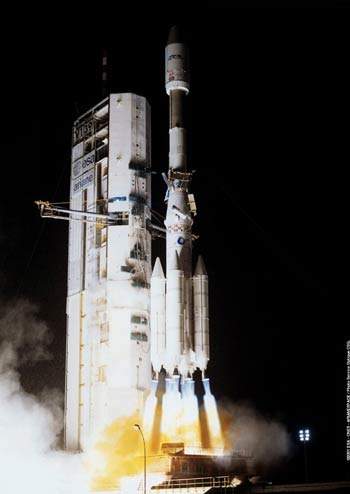In its 61st consecutive success, an Ariane rocket launched Italy’s Sicral 1 satellite and the British Skynet 4F spacecraft into geostationary transfer orbit from Europe’s Guyana Space Centre. The launch, the 139th flight of an Ariane rocket, was the first time the vehicle lifted two military spacecraft into orbit at once. The project was first conceived in 1996. The launch was successfully completed in 2001.
Sicral EHF communications
Sicral 1 is Italy’s first military satellite. It was designed to operate for ten years from 16.2°E longitude and provide communications to fixed and mobile terminals operated by the Italian military. Sicral is Europe’s first venture into extremely high-frequency (EHF) broadcast frequencies.
Italian officials have said the satellite has capacity in EHF, as well as super high frequency and ultra high frequency, permitting interoperability with US and other European satellite systems.
Sicral-1B
Launched in 2007 to supplement Sicral-1, Sicral-1B will continue operations until 2019. 1B is set to be followed by Sicral-2, which will be operational from 2011 to 2026. Nato chose the Sicral system to develop a network of protected telecommunications available to allied countries.
Wireless communications between naval, terrestrial and air platforms are planned as well. The satellite will provide UHF and SHF-band capacities to Nato forces, under an MoU signed by France, Italy, the UK and the Atlantic Alliance in 2004.
The Italian Ministry of Defence awarded a €103m contract to Alcatel Alenia Space in 2006 to develop Sicral-1B. It was financed by the country’s Ministry of Economic Development.
Alcatel Alenia will also be responsible for the delivery of ground segment subsystems.
Manufacturing and integration of Sicral-1B was undertaken at the company’s facility in Turin. Environmental tests were conducted in Cannes and the payload was manufactured in Rome.
Military communications programme
The Sicral programme has been budgeted at about €500m ($458.8m). In addition to the cost of the construction and launch of Sicral 1, this figure includes the construction, by Alenia Spazio, of a duplicate Sicral skeletal platform, or bus, and long-lead-time items for a Sicral 2 electronics payload.
The figure also includes a Sicral ground control centre and 107 fixed and mobile terminals, including several to be placed on Italian jet-fighter aircraft. The Italian authorities said that Sicral 2 would be built within 18 months if Sicral 1 failed to operate as designed.
Sicral-1B will continue operations until 2019.”
The satellite that will activate the new network of military telecommunications was realised by the Sitab consortium. The consortium is made up of Alenia Spazio (70%), FiatAvio (20%) and Telespazio (10%). The orbiting of Sicral successfully meets the challenge laid down to the Italian space industry in 1996 by the defence administration.
It has also designed, built and integrated the satellite and its various elements, the bus, payload and antennas, as well as the telecommunications networks with the radio stations for the mission control centre and satellite control centre. These have been designed, built and integrated by Alenia Spazio.
Sicral launch and propulsion
FiatAvio is responsible for the launch service, the satellite propulsion system and some ground equipment (time and frequency, computers and shelters). The propulsion system for Sicral, designed and built by FiatAvio gives the satellite the impulse needed for insertion in the planned geostationary orbit and for attitude control during its operational life.
Bracciano control centre
Telespazio was made responsible by the Defence Administration for the management of all the activities necessary for the complete operability of the Bracciano Control Centre in the context of the Sicral programme. It also guarantees the full functionality of the entire system: satellite, orbital management and control centre, communication networks and terminals.
Moreover, Telespazio also manages the LEOP (launch and early orbit phase) activities of Sicral: the collective operational phases of satellite command and control carried out from when the spacecraft is released from the launcher up to final orbital position and required altitude.









